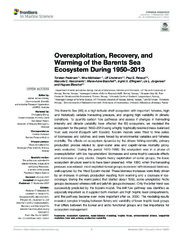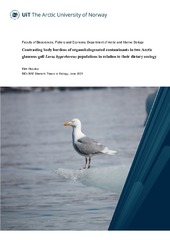Institutt for arktisk og marin biologi: Nye registreringer
Viser treff 821-840 av 2086
-
Overexploitation, Recovery, and Warming of the Barents Sea Ecosystem During 1950–2013
(Journal article; Tidsskriftartikkel; Peer reviewed, 2021-09-17)The Barents Sea (BS) is a high-latitude shelf ecosystem with important fisheries, high and historically variable harvesting pressure, and ongoing high variability in climatic conditions. To quantify carbon flow pathways and assess if changes in harvesting intensity and climate variability have affected the BS ecosystem, we modeled the ecosystem for the period 1950–2013 using a highly trophically ... -
The paradox of forbs in grasslands and the legacy of the mammoth steppe
(Journal article; Tidsskriftartikkel; Peer reviewed, 2021-09-07)The grassland biome supports an enormous diversity of life and includes ecosystems used extensively by humans. Although graminoids lend grasslands their characteristic appearance, forbs are largely responsible for their taxonomic, phylogenetic, and functional diversity. In terms of abundance, however, forbs often play a subordinate role relative to graminoids. Yet this may be a relatively recent ... -
Cultural and linguistic diversities are underappreciated pillars of biodiversity
(Journal article; Tidsskriftartikkel; Peer reviewed, 2020-10-07) -
Sea ice reduction drives genetic differentiation among Barents Sea polar bears
(Journal article; Tidsskriftartikkel; Peer reviewed, 2021-09-08)Loss of Arctic sea ice owing to climate change is predicted to reduce both genetic diversity and gene flow in ice-dependent species, with potentially negative consequences for their long-term viability. Here, we tested for the population-genetic impacts of reduced sea ice cover on the polar bear (<i>Ursus maritimus</i>) sampled across two decades (1995–2016) from the Svalbard Archipelago, Norway, ... -
Time-series of cloud-free sentinel-2 ndvi data used in mapping the onset of growth of central Spitsbergen, Svalbard
(Journal article; Tidsskriftartikkel; Peer reviewed, 2021-08-02)The Arctic is a region that is expected to experience a high increase in temperature. Changes in the timing of phenological phases, such as the onset of growth (as observed by remote sensing), is a sensitive bio-indicator of climate change. In this paper, the study area was the central part of Spitsbergen, Svalbard, located between 77.28°N and 78.44°N. The goals of this study were: (1) to prepare, ... -
Contrasting body burdens of organohalogenated contaminants in two Arctic glaucous gull Larus hyperboreus populations in relation to their dietary ecology
(Master thesis; Mastergradsoppgave, 2021-06-12)This study compared body burdens of organohalogenated contaminants (OHCs) between glaucous gull populations from Bjørnøya and Kongsfjorden, Svalbard and if OHC levels was influenced by their dietary ecology and biological variables (body condition index and sex). To do so, blood from 112 adult glaucous gulls were sampled during the breeding seasons of 2015 until 2019 in Bjørnøya and Kongsfjorden. ... -
Effect of scavenging on predation in a food web
(Journal article; Tidsskriftartikkel; Peer reviewed, 2021-04-26)<ol> <li>The fasting endurance hypothesis (FEH) predicts strong selection for large body size in mammals living in environments where food supply is interrupted over prolonged periods of time. The Arctic is a highly seasonal and food-restricted environment, but contrary to predictions from the FEH, empirical evidence shows that Arctic mammals are often smaller than their temperate conspecifics. ... -
Microbial responses to herbivory-induced vegetation changes in a high-Arctic peatland
(Journal article; Tidsskriftartikkel; Peer reviewed, 2021-03-30)Herbivory by barnacle geese (<i>Branta leucopsis</i>) alters the vegetation cover and reduces ecosystem productivity in high-Arctic peatlands, limiting the carbon sink strength of these ecosystems. Here we investigate how herbivory-induced vegetation changes affect the activities of peat soil microbiota using metagenomics, metatranscriptomics and targeted metabolomics in a comparison of fenced ... -
Seabird guild composition and distribution relative to biophysical cues throughout the Antarctic Peninsula and Scotia Sea
(Master thesis; Mastergradsoppgave, 2021-08-16)Seabird distributions reflect physical and biological features of the marine environment and their variability on different spatial and temporal scales. Different species assemblages are associated with specific oceanic habitats and concentrations of birds typically occur in areas of high biological productivity. Here I explore seabird distributions and habitat use relative to biophysical cues of ... -
Poleward shifts in marine fisheries under Arctic warming
(Journal article; Tidsskriftartikkel; Peer reviewed, 2021-07-16)As global warming makes the Arctic Ocean more accessible, concerns have been raised about the environmental consequences of a possible expansion of commercial fisheries into pristine marine ecosystems. Using a recently released global dataset, we quantify for the first time how fishing activities are responding to diminishing sea ice and a warmer Arctic Ocean. We show that trawling dominates Arctic ... -
Climate variability and density-dependent population dynamics: Lessons from a simple High Arctic ecosystem
(Journal article; Tidsskriftartikkel; Peer reviewed, 2021-09-09)Ecologists are still puzzled by the diverse population dynamics of herbivorous small mammals that range from high-amplitude, multiannual cycles to stable dynamics. Theory predicts that this diversity results from combinations of climatic seasonality, weather stochasticity, and density-dependent food web interactions. The almost ubiquitous 3- to 5-y cycles in boreal and arctic climates may theoretically ... -
Developing common protocols to measure tundra herbivory across spatial scales
(Journal article; Tidsskriftartikkel; Peer reviewed, 2021-03-12)Understanding and predicting large-scale ecological responses to global environmental change requires comparative studies across geographic scales with coordinated efforts and standardized methodologies. We designed, applied, and assessed standardized protocols to measure tundra herbivory at three spatial scales: plot, site (habitat), and study area (landscape). The plot- and site-level protocols ... -
Moving forward in microplastic research: A Norwegian perspective
(Journal article; Tidsskriftartikkel; Peer reviewed, 2021-08-03)Given the increasing attention on the occurrence of microplastics in the environment, and the potential envi-ronmental threats they pose, there is a need for researchers to move quickly from basic understanding to applied science that supports decision makers in finding feasible mitigation measures and solutions. At the same time, they must provide sufficient, accurate and clear information to the ... -
Metabarcoding as a quantitative tool for estimating biodiversity and relative biomass of marine zooplankton
(Journal article; Tidsskriftartikkel; Peer reviewed, 2021-08-31)Although metabarcoding is a well-established tool for describing diversity of pelagic communities, its quantitative value is still controversial, with poor correlations previously reported between organism abundance/biomass and sequence reads. In this study, we explored an enhanced quantitative approach by metabarcoding whole zooplankton communities using a highly degenerate primer set for the ... -
Feeding ecology of harbor seals (Phoca vitulina) in the outer Oslofjord quantified by DNA metabarcoding of scat soft-matrix and morphological analysis of hard prey remains
(Master thesis; Mastergradsoppgave, 2021-08-15)The feeding ecology of harbor seals in the outer Oslofjord was investigated during late summer and autumn of 2019 using DNA metabarcoding and morphological hard-parts identification. To evaluate potential competition between seals and fisheries, the annual consumption of fish by harbor seals was estimated and compared to the fisheries landings in the outer Oslofjord. Fish species from 16 and 18 ... -
Integrated Methods for Monitoring the Invasive Potential and Management of Heracleum mantegazzianum (giant hogweed) in Switzerland
(Journal article; Tidsskriftartikkel; Peer reviewed, 2020-03-23)Biological invasions are a major driver of human-induced global environmental change. This makes monitoring of potential spread, population changes and control measures necessary for guiding management. We illustrate the value of integrated methods (species distribution modelling (SDM), plant population monitoring and questionnaires) for monitoring and assessing invasions of Heracleum mantegazzianum ... -
Status and trade assessment of parrots listed in CITES Appendix I. Scientific Opinion of the Panel on Alien Organisms and trade in endangered species (CITES)
(Research report; Forskningsrapport, 2020-12-18)Parrots are one of the most species-rich groups of birds of which the majority inhabits tropical and subtropical forests. Nearly one-third of parrots are threatened with extinction (IUCN categories CR, EN or VU) and more than half of the world’s parrot species are assumed to be decreasing in numbers. Parrots are popular pets on all continents, mainly due to their colourful feathers, their capacity ... -
Kunnskapsstatus for bruk av molekylære verktøy i kartlegging og overvåkning av biologisk mangfold i marine miljø
(Research report; Forskningsrapport, 2021-06-02)Denne rapporten er bestilt av Miljødirektoratet fra NorBOL (Norwegian Barcode of Life), et nasjonalt nettverk av forskningsinstitusjoner som koordineres av NTNU Vitenskapsmuseet. Universitetsmuseet i Bergen har hatt prosjektledelsen. Rapporten gir en oppsummering av dagens status på DNA-basert metodikk som verktøy i kartlegging og overvåking av biologisk mangfold i det marine miljø. Fokus har vært ... -
Nye frøblandingar for meir stabil grovfôrproduksjon
(Research report; Forskningsrapport, 2021-04-23)Såvareverdikjeda i Norge er svært fragmentert samanlikna med land der same firma er ansvarleg for heile prosessen frå utvikling av ny sort til sal av frø. Dette forprosjektet har som mål å definera korleis ein gjennom meir forskningsbaserte frøblandingar og ferdig testa frøblandingar der bonden kan velja ut frå sine dyrkingsforhold og sin driftsmodell, kan auka avling og varighet av engvekstar. Dette ... -
Økt kunnskap om økologisk tunnelproduksjon av bær. Sorter, gjødsling, dyrkingsteknikk
(Research report; Forskningsrapport, 2021-04-16)Bærproduksjon i plasttunnel har blitt trukket frem som en løsning for økologisk bærdyrking. Et slikt produksjonssystem er relativt nytt i Norge, og det er behov for mer kunnskap for å optimalisere produksjonen. I perioden 2017-2019 har vi gjennom prosjektet “Økologisk tunnelbær og flytende næring”, finansiert av Kunnskapsutviklingsmidler for økologisk produksjon i NIBIO, hatt ulike forsøk ved ...


 English
English norsk
norsk


















